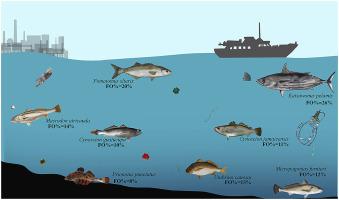Environmental Pollution ( IF 8.9 ) Pub Date : 2020-08-27 , DOI: 10.1016/j.envpol.2020.115508 J Gabriel B Neto 1 , Fábio L Rodrigues 2 , Ileana Ortega 3 , Lucas Dos S Rodrigues 3 , Ana L D F Lacerda 1 , Juliano L Coletto 1 , Felipe Kessler 4 , Luis G Cardoso 1 , Lauro Madureira 3 , Maíra C Proietti 1

|
Rising concentrations of plastics in the oceans are leading to increasing negative interactions with marine biota, including ingestion by endangered and/or economically important seafood species such as fish. In this paper, we visually evaluated plastic debris ingestion by 965 specimens of eight commercially exploited fish species from different marine habitats off the southeast-south coast of Brazil. All species ingested plastics, with pelagic animals having higher amounts, frequency of occurrence, diversity and sizes of ingested items than demersal-pelagic and demersal animals. Highest frequency of occurrence (FO%) of plastic ingestion (25.8%) was observed for the pelagic skipjack tuna Katsuwonus pelamis (Scombridae), and lowest (5%) for the demersal bluewing searobin Prionotus punctatus (Triglidae). Microplastics predominated in all species, and fibers/lines and fragments were the main items found, possibly derived from fishing materials. The most abundant plastic colors were transparent, black and blue, and the most common polymers were polyamide and polyurethane. With the available data, no relationship between the size of the individuals and amount of ingested plastics was observed. Considering the negative impacts of plastic ingestion on marine fish, and potentially on human health due to their consumption, understanding ingestion patterns is critical for better evaluating their origin and possible causes, and consequently for helping define prevention strategies for this problem.
中文翻译:

在巴西东南南部,具有商业意义的重要海水鱼类摄入塑料碎片。
海洋中塑料的浓度不断升高,导致与海洋生物群的负面相互作用增加,包括被濒危和/或具有经济重要性的海产品(如鱼)摄入。在本文中,我们通过从巴西东南沿海附近不同海洋生境中的八种商业开发鱼类的965个标本直观地评估了塑料碎片的摄入。所有种类都摄入塑料,而远洋动物比深海-远洋和深海动物的摄入量,发生频率,多样性和大小更大。浮游金枪鱼Katsuwonus pelamis(Scombridae )的塑料摄入最高发生频率(FO%)(25.8%),而深海蓝鳍金枪鱼Prionotus punctatus的最低频率(5%)(Triglidae)。在所有物种中占主导地位的是微塑料,发现的主要物品是纤维/细线和碎片,可能来自捕鱼材料。最丰富的塑料颜色是透明,黑色和蓝色,最常见的聚合物是聚酰胺和聚氨酯。利用现有数据,未观察到个体大小与摄入塑料量之间的关系。考虑到塑料摄入对海洋鱼类的负面影响,以及由于食用塑料而可能对人体健康造成的影响,因此,了解摄入方式对于更好地评估其来源和可能的原因至关重要,因此有助于确定该问题的预防策略。



























 京公网安备 11010802027423号
京公网安备 11010802027423号